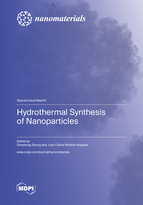Hydrothermal Synthesis of Nanoparticles
A special issue of Nanomaterials (ISSN 2079-4991). This special issue belongs to the section "Synthesis, Interfaces and Nanostructures".
Deadline for manuscript submissions: closed (20 February 2022) | Viewed by 30614
Special Issue Editors
Interests: supercritical hydrothermal synthesis of metal and metal oxides; non-equilibrium material synthesis; metal substitution; organic-inorganic hybrid materials; nanocatalysts; heavy oil upgrading; lignin degradation; methane reforming; methane oxidative coupling reaction
Special Issues, Collections and Topics in MDPI journals
Interests: hydrothermal synthesis of perovskite oxide materials; hydrothermal self-assembling particle crystal growth on silicate oxides; hydrothermal microwave-assisted processing for nanoparticle synthesis
Special Issues, Collections and Topics in MDPI journals
Special Issue Information
Dear Colleagues,
Hydrothermal synthesis of nanoparticles is a processing technique that has gained particular interest in material science in the last two decades. The recent developments in the preparation of nanoparticles by heterogeneous chemical solution reactions favored the production of a large number of advanced functional materials. Additionally, the particle size control enhanced by high crystallization kinetics occurring in aqueous substances provides the sufficient conditions to produce nanoparticles of various inorganic compounds. The innovation of technology triggers the challenge of optimizing the synthesis of nanostructured advanced and functional materials to overcome the requirements of the current technology. Hence, the hydrothermal synthesis (including supercritical region) of nanoparticles has emerged as a sustainable technique to produce inorganic materials on a large scale in continuous flow reactors at a relatively low cost.
Therefore, this Special Issue intends to gather state-of-the-art advances, regardless of selective contributions, in the research on the hydrothermal synthesis of nanomaterials. Original and review papers on scientific fundamentals and technological applications of the hydrothermal synthesis of nanoparticles of new nanomaterials for energy storage, catalysis engineering use, and environmental sustainability challenges are particularly welcome.
Dr. Gimyeong Seong
Dr. Juan Carlos Rendón-Angeles
Guest Editors
Manuscript Submission Information
Manuscripts should be submitted online at www.mdpi.com by registering and logging in to this website. Once you are registered, click here to go to the submission form. Manuscripts can be submitted until the deadline. All submissions that pass pre-check are peer-reviewed. Accepted papers will be published continuously in the journal (as soon as accepted) and will be listed together on the special issue website. Research articles, review articles as well as short communications are invited. For planned papers, a title and short abstract (about 100 words) can be sent to the Editorial Office for announcement on this website.
Submitted manuscripts should not have been published previously, nor be under consideration for publication elsewhere (except conference proceedings papers). All manuscripts are thoroughly refereed through a single-blind peer-review process. A guide for authors and other relevant information for submission of manuscripts is available on the Instructions for Authors page. Nanomaterials is an international peer-reviewed open access semimonthly journal published by MDPI.
Please visit the Instructions for Authors page before submitting a manuscript. The Article Processing Charge (APC) for publication in this open access journal is 2900 CHF (Swiss Francs). Submitted papers should be well formatted and use good English. Authors may use MDPI's English editing service prior to publication or during author revisions.
Keywords
- Hydrothermal synthesis
- Supercritical fluids
- Reaction kinetics
- Morphology control
- Crystallization
- Crystal growth
- Heterogeneous chemical reactions
- Catalysts
- Nanoparticles
- Functional materials








